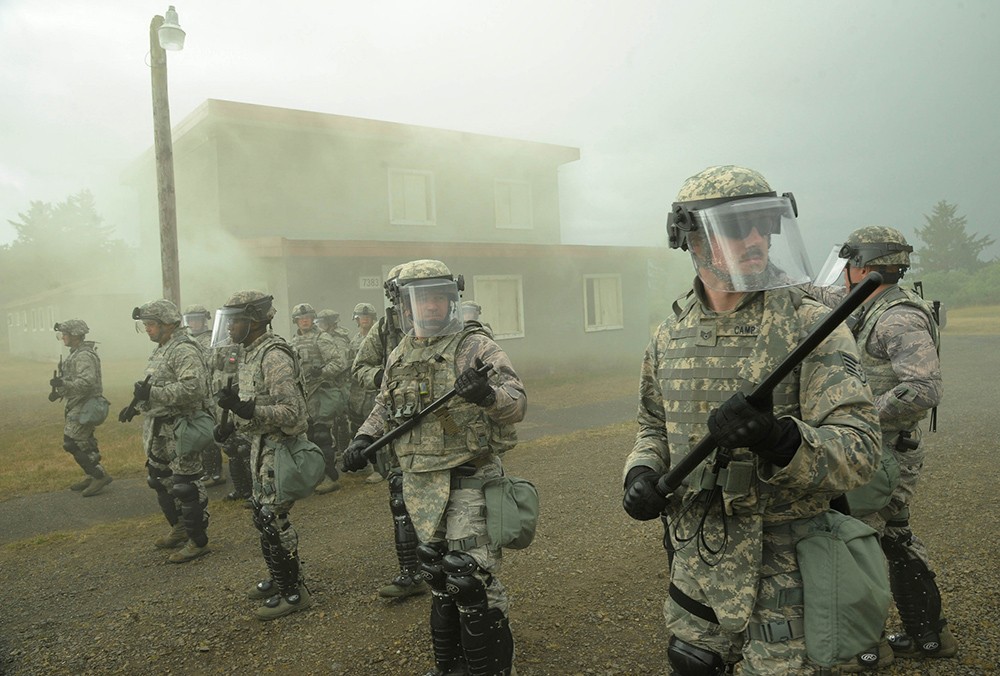
©U.S. Airforce, 2016. Oregon Air National Guard security forces train for a door-to-door search at a training village in Warrenton, Oregon, during the Cascadia Rising exercise on June 10.
In July 2015, many eyes were opened to the dangers of the Cascadia subduction zone thanks to a New Yorker article that outlined the stark impacts a large-magnitude quake could have on the Pacific Northwest. Nearly a year later, emergency officials had a new awakening—Washington State wasn’t nearly ready to face them.
The realization first became apparent during the multi-state Cascadia Rising preparedness drill, which took place June 7-10. It became official last week, however, when the state released the final draft of the action report, finding its current approach to disaster response would be “grossly inadequate” to address anything like the 9.0 magnitude earthquake and resulting tsunami scenario projected in the drill.
“Everything we depend on to live our 21st-century lives is going to be significantly degraded or eradicated,” Washington Emergency Management Director Robert Ezelle told the Seattle Times. “The needs are going to be immediate, they are going to be urgent and they are going to be overwhelming.”
A lot of that devastation is due to the extent of damage such a scenario would create, including more than an estimated 14,500 dead and 27,000 injured across Washington and Oregon. If such a situation happened, the Washington report states, there would be severe food and water shortages, sanitation problems, healthcare crises, and inoperable power grids and transportation systems. Millions of people would be affected and much of the infrastructure needed to help them—including response teams, physical equipment, fuel, and vehicles—will also have been decimated.
With that in mind, the current system—which waits until local capacity is exhausted before bringing in state and federal assistance—would be useless in a large-scale catastrophe. Instead, the report states, Washington needs to develop a comprehensive incident response plan to use in catastrophic situations.
Other issues identified were communication, a lack of seismically resilient buildings and infrastructure, and especially understaffed and underfunded emergency management departments.
“If this event happens, the first question everybody is going to ask is: ‘How come you weren’t ready?’ Grays Harbor County Emergency Manager Chuck Wallace told the Seattle Times. “Right now, we’re working with pennies.”
That is true in all three states—Washington, Oregon, and Idaho—that participated in the drill, according to the multi-state assessment provided by the Seattle Times. That report, which doesn’t make recommendations for addressing the problems, found that skimping on emergency staffing meant some jurisdictions were unaware of basic emergency management tools, such as the National Response Framework, and unable to support emergency operation centers. Additionally, response agencies would face difficulties prioritizing who received critical supplies of water, food, and fuel, according to the report.
“Tough conversations on how to best distribute limited resources to meet the needs of the greatest number need to occur in advance of a catastrophic incident to ensure resources are distributed effectively,” the report suggests.
One answer to this problem is to make sure the public knows they need to play a part in their own survival. Washington State will begin asking residents to stock enough supplies to last two weeks, according to Reuters.
That tack could have duel benefits—making sure people are both prepared, and planting the seeds of what Robert Muir-Woods called a disaster culture in a recent Los Angeles Times opinion piece. Even in places like California that has long known its earthquake risk, such a culture is only beginning to take hold.
Hopefully, the Pacific Northwest will have a sharper learning curve, because drills and disaster plans can only abate a portion of the impact.
“Although the agent is natural in disasters like earthquakes, the catastrophe that follows is all too human and unnatural,” Muir-Woods writes. “Its severity depends entirely on how well the city prepares, how strong a “disaster culture” it has built.”
Jolie Breeden is the lead editor and science communicator for Natural Hazards Center publications. She writes and edits for Research Counts; the Quick Response, Mitigation Matters, Public Health, and Weather Ready Research Award report series; as well as for special projects and publications. Breeden graduated summa cum laude from the University of Colorado Boulder with a bachelor’s degree in journalism.